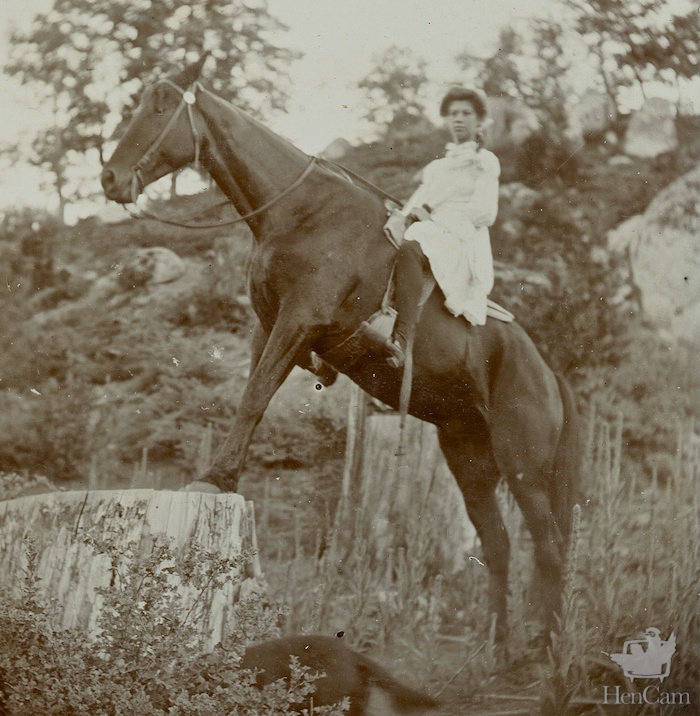There are many reasons why a person does animal training. There’s the basic, you have to get along, training: pay attention, no biting, no kicking, go where I need you to go. There’s the training for usefulness: herd the sheep, find the bad guy, guide the blind, pull this cart. There’s sport: flush the quail, go over the jump, catch the frisbee. Much of training is simply for fun: roll over, high five.
All training requires communication between the handler and the animal. Some people train for compliance: do what I say or there are serious consequences. I’d rather train for cooperation: this will be rewarding for both of us.
Although the study of behavior is a relatively new science, animal training has been going on for thousands of years. The Greek soldier, Xenophon, wrote about horsemanship in 400 BC, and the debate over how to work with the animals in our lives hasn’t stopped since then.
I don’t know what training methods Myrtle used with her horse Tony.
But I have a feeling that they were quite the team.



I think Myrtle was having fun…and Tony was doing the same..like minds..you know????
I agree, they look content with each other. Donna, can you imagine riding in those little pointy shoes with bows?
Terry I think you should dress like that the next time you take a ride on Tonka ;-)
It would be quite eye catching.
I would get all tangled up in the skirt and you’d see quite the trick :)
I have to wonder if she didn’t catch hell for (1) riding astride and (2) with a “short” skirt. And my feet shuddered when I looked at those shoes!
Did you know that one of the major causes of clothing reform for women was the influence of the cowgirl and her split skirts? In fact the dime store novel popularized and legitimized looser clothes and eventually pants. Women on working ranches rode astride.
It would be quite the trick to rope cattle riding side-saddle!
Hey, I’m not so sure….Tony doesn’t look all that happy to me! More resigned. :(
Tony’s ears are back, but not pinned, and his mouth is relaxed. I have a zillion photos of Tonka looking like that, but with a digital camera, I can take oodles and find one with his ears forward, looking pleased.
I’m reminded of something I once read about performing elephants. The animal lover said something to the effect that he’d never seen an elephant balancing on just their forelegs in nature, or doing the pachy-version of a Spanish Walk without sharp ended training sticks somewhere just out of sight and before we clap too loudly, we might want to consider the activity was not done freely but manipulated out of the animal — whether cruelly or not. I love horses and have ridden most of my life, (3 day eventing), but now prefer to just ‘commune’ with the horse, and be grateful that he agrees to carry me along on his ride. I love seeing pictures of you and Tonka just riding along, and to hear how much you try to make every encounter a win-win one.
Tracy, I’ve also been turned off to much of competitive riding because of how aversive much of the training is. And, certainly there are instances in which animals are forced to do acts, and inhumane training techniques are used, in order to please the public (or even just the ego of the owner) but I wouldn’t use that to paint all behaviors as inhumane if you don’t see it in “nature.” In fact, by training animals, you can learn much that can’t be learned through observation (that observation is often in unnatural “natural” or confined surrounds.) A training relationship in which the animal has a channel for dialog, allows the animal to tell us a huge amount about himself. Horses are rewarded not just by treats, but also by their innate desire for accomplishment. They are also animals keyed into a close relationship with their herd and with humans. Training, even (and especially) behaviors that an animal wouldn’t normally think of doing, can enrich an animal’s life. My reading of Tony’s tricks is that he’s being asked to do something interesting, and that he feels rewarded for that. Training, even training that requires hard physical work and mental challenge, is not necessarily negative, in fact, I’d argue, that done well, it is a far better life for a horse than being a pasture potato. Even to have a lovely, quiet walk on a horse requires on-going training. (I know plenty of novice riders who wish that they could do something so “simple.”) Having a rider on a back is not “natural” in the wild. I’d argue that you’re able to commune as happily as you do because of your skill as a trainer and rider.
Hi Terry,
We can agree to disagree about our respective speculations on Tony. I do agree with you completely that not all training is negative, and didn’t mean to convey that. I enjoy Marty Robinson’s books for that reason; just understanding how a horse perceives, what ‘safety’ feels like for him, how he communicates, etc. can create such a very real bond. The whole concept of ‘joining up’, for example, is so easy to achieve and so basic in creating that real, organic bond with a horse.
I do think the paradigm is quite different for prey animals like horses and those who naturally seek a more interactive relationship with man, such as dogs.. I have Jack Russells for example, and one in particular that actually craves to learn new tricks — literally pursues me to teach her something new. She loves the engagement, loves the mental challenge of trying to figure out what I want and in what order. She just about bursts out of her skin when she gets it ‘right’ and we ‘celebrate’ with praise. Dogs, I think, (many anyway) certainly do possess that desire for connection and even accomplishment. For her, teaching her a new trick a week is as important to her as breathing. (We’re working on teaching her to load small items into the dishwasher now, building on her ability to pick things up and put them in the waste basket. She can also bark with an “inside voice” with her lips entirely closed…that took a bit of doing, but now all I have to do is pinch my own lips for her to bark quietly. Redirect, redirect!)
But as much as I love them, and I surely do, I’m not sure horses are wired the same way. With the exceptions of stallions that are so driven by testosterone, for mares and geldings I think, life is more about understanding their role or status in the herd, about avoiding danger, and keeping peace. Horse racing is based purely on the animal’s fear (starting bell creates panic, whips replicate claws of attacking predators, desire to ‘go to the lead’ is more about herd instinct and a fear of being left behind while in a panic, etc.) Horses aren’t natural jumpers and their limbs are not really evolved to absorb the level of concussion and stress show jumping, hunting, etc. places on them. And don’t get me started on rodeo, barrel racing, anything happening in a saddle seat class….sigh. Now when I ride, I use my most basic principles of dressage and just try to ‘get out of the horse’s way’ and build on their natural abilities and movements, only introducing gentle resistance when it helps them overcome the problems my weight introduces.
I just love the pictures that show you and Tonka moving forward –figuratively side by side– just enjoying each other’s company and simply trying to give what the other needs. Call it humane training, call it building a true and enjoyable bond; it just seems like you’re letting him be a horse, albeit a polite one with manners, and he’s willing to try his best to be a good partner to you. (He also has such a kind eye…and that trumps just about everything!) You can feel his honesty through the screen.
Thanks for listening, I don’t mean to dominate the discussion and will hush now. I love your blog and read it every single day. Thanks so much for that.
Tracy
Tracy, your comment is thoughtful and kind, and you speak from horse experience and not a knee-jerk animal rights attitude, so I’m happy to engage and respond. I’ll address a few of your points:
You are right that horses are not wired like dogs. It’s unfortunate for other animals that we hold our relationship with dogs as the gold standard for friendships with other species. Dogs are hardwired to read our body language in minute details. They’ve evolved and have been bred for us to see their expressions and emotions as like our own. They engage, they play in a way that we understand, and they cater to our every whim. They wear their intelligence and love on their sleeve, so to speak. Horses express themselves in very different ways than dogs. However, despite the fact that horses are prey animals, I don’t believe that they see humans as predators. Rather, they are also wired to have deep friendships, not just with the herd, but with us people. They express that friendship in far more subtle ways than dogs. They have a different intelligence. Let go of the comparison to dogs and you can see them better. There are times when I think that Tonka is inscrutable. At those moments I just breathe and watch and stand with him, and then I get the connection. It’s subtle stuff.
I think that too much is made of how “unnatural” it is for a horse to carry the weight of a rider. Each horse is unique, and some, honestly, aren’t athletes; but well-built horses, with proper conditioning, are just fine carrying a rider, and even fine taking part in sports and long trail rides. That said, it takes years of lessons for a person to be able to be agile, balanced and tactful. Horses, treated right, are very tolerant of this! I knew a horse who loved his rider, to the point where, when jumping, he would shift under her to make sure that she stayed on! And I’ve seen lesson ponies slow down so that their riders could regain their balance. (On the other hand are the horses who try to unseat you… that’s the other half of this story, but it is one that can be changed with kindness and good training, or medical help.)
As far as your concerns about so many horse sports being abusive – there’s truth in much of it, but there’s also those who do it right (though I’ve yet to see the “right” in saddle seat.) I’ve known horses who have loved the extreme sports as much as the riders. But it’s not for everyone, and sadly, many people don’t realize their or their horse’s limits. I don’t know what Tonka’s are yet. We’re having lots of conversations. Meanwhile, I’ve bought a new saddle, because he’s getting fit and the one I bought 4 months ago was pinching his developing muscles. Those are muscles that he’s enjoying, and now that the saddle is comfortable, he’s moving big. Horses thrive on movement, it’s a reward unto itself. The trick is to figure out how to move together. It can take a lifetime. But I truly believe that the horse can be into the process as much as the rider.
Beautiful photos, and interesting discussions!